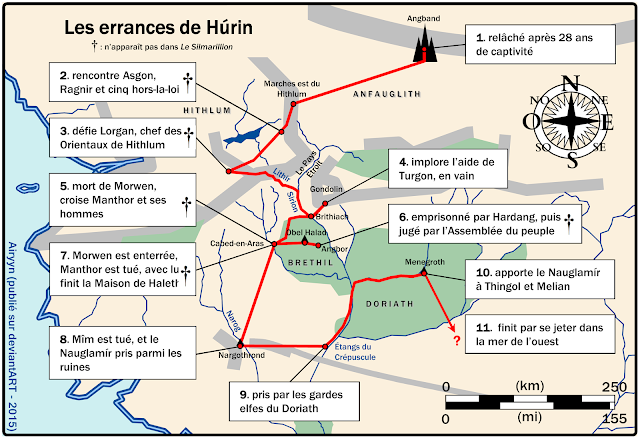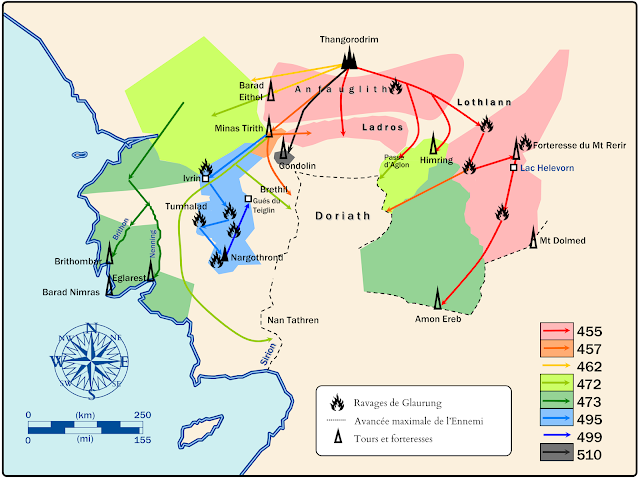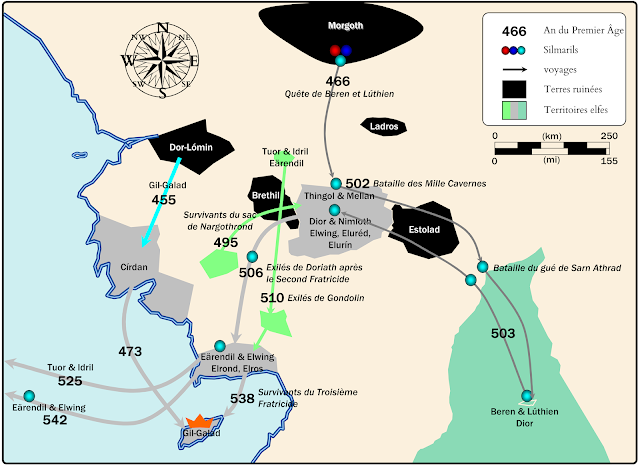(cliquez sur l'image pour l'agrandir)
Les conquêtes de l'Ennemi (Atlas du Beleriand - Carte 8)
Durant le Premier Âge, la puisssance de Morgoth augmenta de manière continue. Les caves les plus profondes d'Angband étaient remplies d'armes, d'esclaves et de soldats. Morgoth n'appliqua qu'une seule stratégie : la conquête brutale. N'étant pas lui-même sur les champs de bataille, des Balrogs menaient les troupes. De ce point de vue, Sauron se révéla bien plus rusé que son maître.
Du point de vue de l'Ennemi, la division Est/Ouest du Beleriand est une difficulté car il doit diviser ses troupes. Le corridor Est (la passe de Maglor) était défendu par les fils de Fëanor, tandis que le corridor ouest (le Val du Sirion et la forteresse de Minas Titith - homonyme de celle du
Seigneur des Anneaux) était défendu par les fils de Finarfin.
Le dragon Glaurung fut une pièce maîtresse dans l'avancée de Morgoth, puisque le dragon gagna toutes les batailles (excepté lors de sa première sortie en 260). Il bris les défenses à l'Est en 455, et enfonca l'Ouest cinquante ans plus tard. Glaurung seul aurait pu conquérir le Beleriand, mais il possédait sa volonté propre [1] et son destin rencontra celui de Túrin Turambar.
Morgoth ne put jamais conquérir tout le Beleriand : Ulmo protégeait Nan Tathren et le Sirion, et la forteresse d'Amon Ereb resta à l'Est.
Doriath fut régulièrement attaqué sur deux fronts mais il était protégé par l'Anneau de Melian. Quand Thingol fut assassiné par les Nains, Melian la Maia quitta Doriath et l'Anneau fut dissous. Le royaume fut détruit par les fils de Fëanor et par son serment, non par les orques.
***
A propos de l'Atlas du Beleriand
Cet
Atlas est une série de dix cartes (ou plus!) concernant la géographie,
l'histoire et la géopolitique dans le Beleriand, le territoire des
évènements du
Silmarillion.
Cette carte a été créée pour illustrer
un essai dédié à la géopolitique en Beleriand publié sur le site
JRRvf. La carte a été améliorée et ensuite
publiée sur Deviantart.
***
Détails techniques
Deux polices de caractères ont été utilisées : Franklin Gothic Medium et
Cardo de David J. Perry.
***
Bibliographie et références
[1] HoMe V p254









